
How to Pick the Best Platform to Make a Crazy Successful Blog? The Top 10 Blog Sites in 2024
People and businesses today rely heavily on blogs to exchange ideas, experiences, and information.
Regardless of your level of experience as a journalist or as a brand looking to expand its online presence, you may select the ideal blog site.It has the power to greatly impact the production, distribution, and interpretation of your content by your audience.
Using this comprehensive guide, you will discover what makes a good blog site, quickly scan the best ones, and choose the best platform for your writing needs.
How can one create a quality blog?
More than simply a location to publish articles, a successful blog site facilitates user-friendliness, allows for modification, promotes community involvement, and is visible so that the appropriate people see your material.
Look for these essentials:
- Easy of Use: simple writing, editing, and publishing interface.
- Customization: The theme and style of the design are modifiable to suit your blog.
- SEO tools: Through the optimization of your content for search engines, SEO tools assist you get visibility.
- Community features: include enabling links, comments, and social media sharing of your material.
- Possibilities to Earn Money: Bloggers ought to employ platforms that let them monetize their writing.
Looking Quickly at the Top Ten Blog Sites
This table divides the best blog sites into paid and free groups based on the most important characteristics to make your decision between them quickly:
| Platform | Type | Key Features |
| WordPress.com | Premium | Customization, SEO, Monetization |
| Squarespace | Premium | Design, E-commerce, Analytics |
| Wix | Premium | Drag-and-Drop Builder, Apps, Design |
| Ghost | Premium | Speed, SEO, Minimalism |
| Medium | Premium | Audience, Simplicity, Community |
| Blogger | Free | Ease of Use, Google Integration |
| WordPress.org | Free | Customization, Control, Community |
| Medium (Basic) | Free | Simplicity, Audience, Engagement |
| Tumblr | Free | Social Networking, Multimedia |
| Substack | Free | Newsletter Integration, Simplicity |
Best Five Paid Blog Platforms
1. WordPress.com
WordPress.com’s wealth of themes and plugins may appeal to professionals and businesses. It will work best for blogs looking for the most customisation and control over their website.
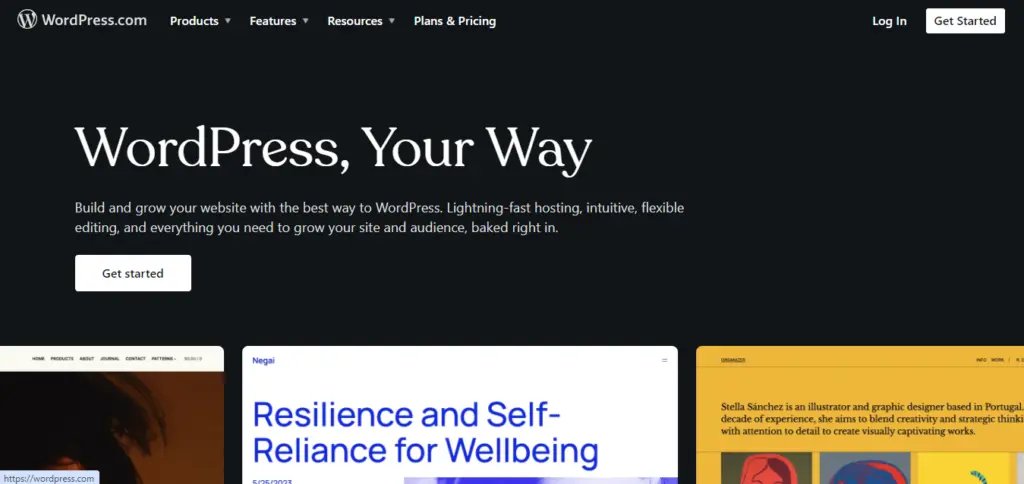
Advantage:
- WordPress Unmatched Customization: With the thousands of themes and plugins provided, you may completely change the look and operation of your site.
- Scalability: Both individuals and companies gain from its simplicity of moving from small blogs to big websites with many contributors.
- Search engine: results will show your blog more when you use the integrated SEO tools.
Cons:
- Learning Curve: New users could find the enormous amount of features and customizable options difficult.
- Special Features Cost: There is a free plan as well as membership access to sophisticated themes, plugins, and customizing choices.
- Prices: Business use plans start at $25 per month and provide more features and customizing choices; personal use plans start at $4 per month (paid annually).
2. SpacesSquared
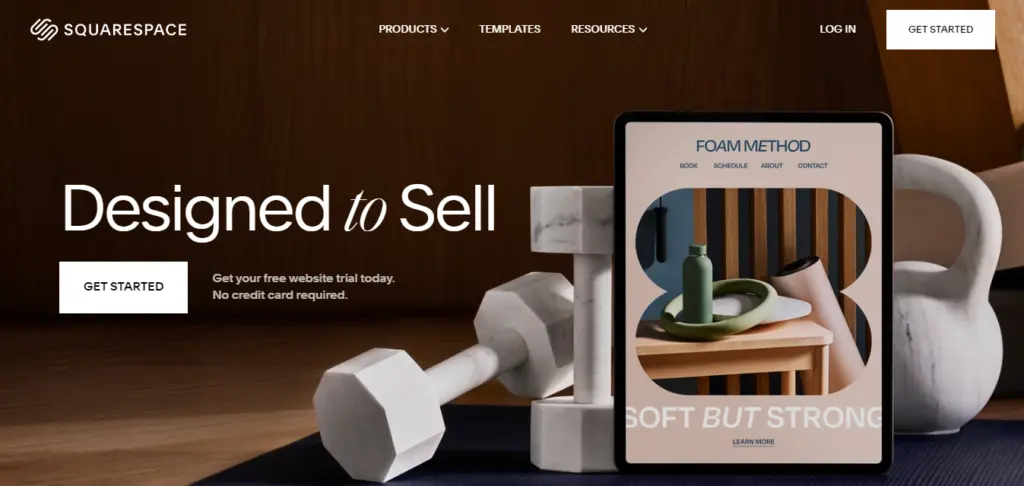
Squarespace is a great tool for creative people who want to quickly build visually spectacular blogs.Its design themes are sleek and its interface is just drag and drop.
Pros:
- Elegant Design Templates: is famous for its beautiful, properly made templates that work well on phones.
- The simple drag-and-drop layout: means that no coding knowledge is required to build great blogs.
- Every time, on one platform: This type of platform simplifies the process of setting up blogs by including hosting, name registration, and e-commerce functionality.
Cons:
- There aren’t as many third-party links: as there are on other platforms, but the ones that are there are useful.
- Pricing: The starting price is higher than for other blogging sites, especially if you want to use the e-commerce features.
Plans start at $12 a month (billed yearly) for personal use. Plans for businesses cost $18 a month and have more tools and integrations.
3. Wix
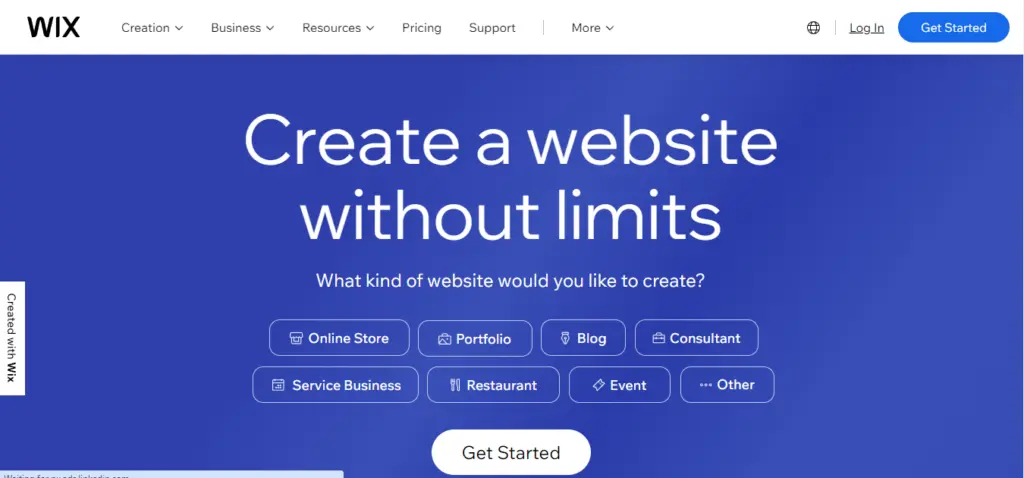
Easy to use and flexible, Wix stands out. It offers bloggers that value the look and functionality of their websites a wide app market and new design options.
Pros:
- Pluses User-Friendly: For those just starting off, it’s a great drag-and-drop website builder.
- Rich App Market: Using any of the many apps and services available in its app market will help you make your blog more functional.
- Flexibility in Design: There are many different motion and design choices available to create distinctive and visually striking websites.
Cons:
- Site Speed: Should a platform cause websites to load more slowly than those created on more effective platforms, search engine optimization and user experience would suffer.
- After a template: is chosen and your website is published, it cannot be changed without a redesign.
Price: It has a free plan that has the Wix logo on it. Premium plans start at $14 a month and get rid of Wix’s ads while giving you more space and speed.
4. Ghost
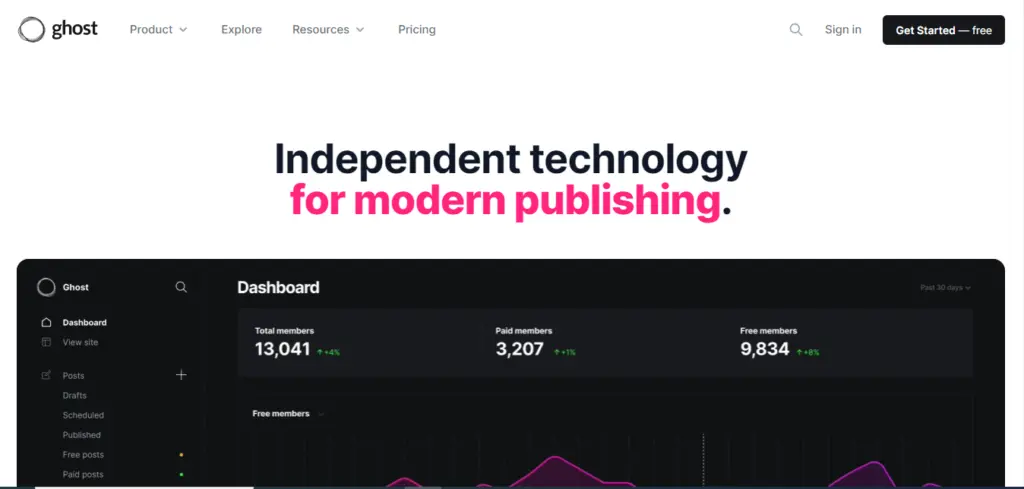
Ghost is a streamlined, SEO-friendly platform that focuses on fast opening times and a clutter-free writing experience for people who care about content and speed.
Pros:
- Emphasis on Content and Speed: Designed to be swift and light, devoid of superfluous features, so that writers and readers may work and read without any difficulties.
- SEO and Social Sharing: Its clean, semantic code, automated sitemap building, and easy social network sharing features were all designed with SEO in mind.
- Features related to Membership and Subscription: Bloggers may easily monetize their content thanks to the direct integration of subscription models.
Cons:
- Less Design Options: Ghost’s theme and customisation options are less than those of WordPress and Squarespace.
- Technical setup required: You will need some basic programming knowledge to set up and maintain the self-hosted version.
Prices: The Starter plan of the hosted Ghost(Pro) version starts at $9 per month when paid for year. Higher-level plans for commercial publishers have more capabilities; this one is intended for personal blogs.
5. Medium

A premium level at medium raises exposure and interaction. For writers hoping to reach a sizable, interested readership, this makes it an excellent venue.
Beneficiaries:
- Built-in Audience: Without having to start from scratch and develop a following, writers on Medium may already connect with readers thanks to the large, vibrant community.
- Simple: Its minimalistic interface doesn’t divert authors or readers and it concentrates on writing and content.
- The Medium Partner Programme: allows writers to be paid according to the number of interactions their posts receive.
Cons:
- Limited Customisation: It doesn’t give you many ways to change how your blog looks or add your own name.
- Dependence on Platform: You have less power over your content because it lives on Medium’s platform. If you want to move to another platform, it will be harder to move your content.
Publishing is free, and you can make money from your work by joining the Medium Partner Programme. Medium doesn’t charge writers, but it does take a cut of the money that members make from reading.
Top 5 Blog Sites That Are Free
1. Blog Author

Blogger is an easy-to-use platform owned by Google that comes with simple blogging tools and works with Google’s other products, making it perfect for people who are just starting out.
Pros:
- Use: Blogger’s simple layout makes it simple for anyone to start a blog, even if they have never done it before.
- Integration with Google’s Suite: It’s easy to keep an eye on things and make money with Google tools like AdSense and Google Analytics.
- Free Hosting: Google runs Blogger blogs for free, making it a safe and inexpensive choice for people who are just starting out.
Cons:
- Not Many Customisation Options: Blogger has a number of themes, but not as many customisation options as newer platforms.
- Less often updates: Google provides Blogger with fewer upgrades and new features than competing platforms.
Use it for free; it is branded Blogspot. One can utilize bought custom domain names on blogger blogs.
2. WordPress.org
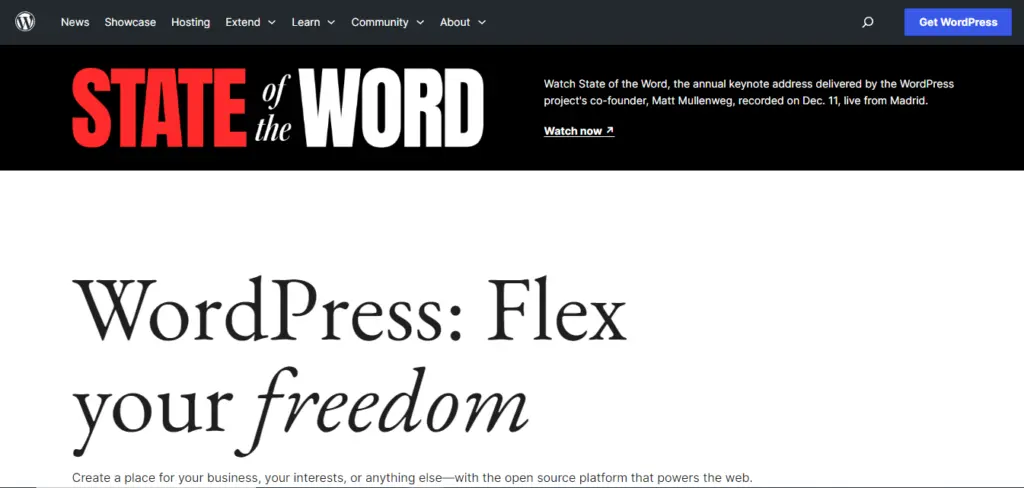
While the self-hosted version of WordPress gives bloggers complete control over the look and functionality of their website, setup requires a little more technical expertise.
Pros:
- Full Control: WordPress.org lets you personalize every part of your website, including the backend features.
- Plugins and styles: You may include almost any function to your website with the help of thousands of plugins and styles.
- Support from the Community: The vast number of users and developers makes tools and help readily available online.
The drawbacks:
- Required Technical Proficiency You must be technical to set up a blog on WordPress.org, including hosting, domain name registration, and routine maintenance.
- Web space and domain name fees are extra; WordPress.org is free.
Prices: WordPress software is free, but basic prices for hosting and domain registration start at around $3 to $5 per month.
3. Simple (Medium)
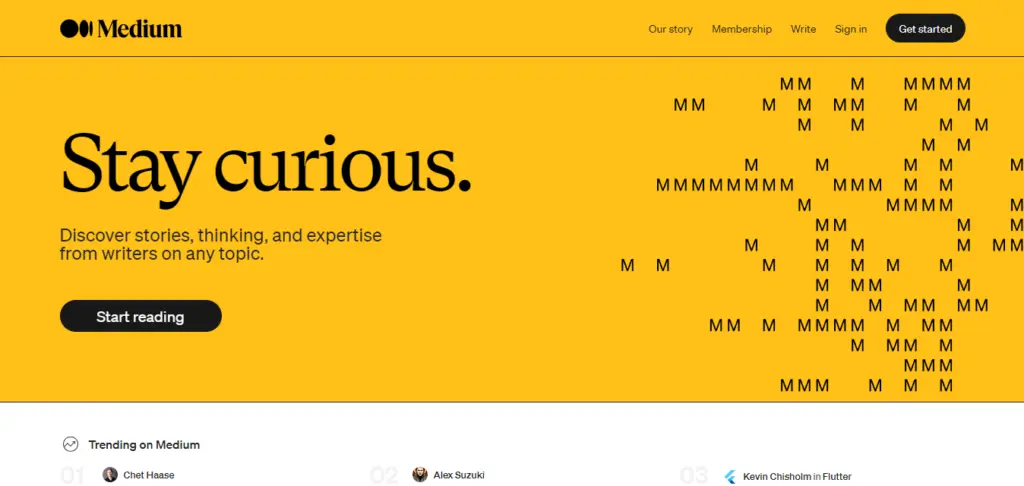
Medium’s basic plan lets writers connect with readers who are already using the service. It’s simple and easy to use, and you don’t need to know anything about technology.
Pros:
- Built-in Audience: Medium gives you a platform with a built-in audience, which makes your work more visible.
- Simplicity: The platform focuses on content creation and has a clean, simple interface for posting and writing.
- No Need for Technical Support: Medium takes care of all the hosting, so bloggers don’t need to know anything about technology or do any upkeep.
Cons:
Less money Streams: The Medium Partner Programme does provide you less money streams than self-hosted websites.
Less brand control: Medium’s homogeneous design makes it difficult to add your own or alter the appearance of the website.
On Medium, base level publishing is free.You may earn from your work by enrolling in the free Medium Partner Programme.
4. Blogger Tumblr

Tumblr is a special fusion of social networking and blogging that is loved by young people and everyone who desire to share multimedia content.
Pros:
- Community involvement: is pushed via following, reblogs, and likes on Tumblr.
- Multimedia friendly: great for sharing, among other things, text, photos, GIFs, and movies.
- Basic features: A Tumblr blog can be simply started and maintained by kids and beginners.
Reverse:
- Its drawbacks are SEO and less customisable options: Generally speaking, compared to other writing platforms, tumblr blogs provide less choices for SEO and customization.
- Audience and Visibility: Tumblr has a strong community, but it might not be the best place to reach a larger or more professional group of people.
Pricing: It’s free to use, but you can buy paid themes if you want to.
5. Substack

For bloggers, Substack upends the status quo by integrating email correspondence. Writers can create a list of devoted readers directly this way.
Features:
- Email Newsletter Integration: Substack combines blogging and email marketing so authors can supply subscribers’ inboxes directly with material.
- Making Money With Subscriptions: Makes it easy to make money from your work by charging people to read it.
- Ease of Use: The site is easy to use, and you don’t need to know anything about technology to focus on writing and managing subscribers.
Cons:
- Design and Customisation Options Are Limited: Substack doesn’t give you many choices for how to design and customise your blog. Instead, it focuses on the content.
- Dependent on Subscriber Base: Building and keeping a committed subscriber list is a big part of being successful on Substack.
Prices: Building and distributing newsletters is free. 10% of the subscription price is paid to Substack.
I should start blogging on which platform?
Your goals, level of technological know-how, and preferred type of content will determine the blogging platform you use. Think on the following when selecting:
- Why are you blogging, in the first place? Is the goal to benefit your company, to have fun, or to improve your professional resume? You will be guided in platform selection by your goal.
- Suggestions for Customization If you would like ultimate control over the appearance and functionality of your blog, check out WordPress.org. Squarespace or Wix could be perfect for systems that stress design and are simple to use.
- Drawing in Your Viewers Groups on sites like Substack and Medium can engage with your material. It will enable you to expand your audience fast.
- Gaining financial success Seek for websites that allow you to charge readers for your blog, have sponsored content, and sell products online if you want to generate money from it.
- Computer Proficiencies Find out how easy you find building and designing websites.For those just starting off, Blogger and Tumblr are excellent options; WordPress.org may require a little more technical expertise.
The ideal blogging platform is the one that most nearly meets your needs, skills, and goals as a blogger.
Taking into account the points already indicated and looking at the benefits of each platform, you may choose wisely to set yourself up for blogging success.
Whatever the blogging platform—paid or free—the most important things are the quality of your posts and how involved your readers are.
Questions and Answers on Blogs
Best blog site?
It depends on your needs, goals, and skill level which blog site is “best” for you.Because WordPress.com is so customizable, both new and experienced users who want total control over their website find it appealing.Anyone that values both usability and excellent design will find Squarespace to be excellent.The best platform is ultimately the one that most closely matches functional, financial, and design criteria.
Exist any really free blogging platforms?
Many websites allow you to start a free blog, including Tumblr, Blogger, and WordPress.org (storage is charged). On many sites, starting a blog is free; but, adding further functionality, getting a custom domain, or removing the platform’s branding are typically not.
Blogs will still exist in 2024.
By 2024 blogs will be widely used for novel, educational, and entertaining purposes. They are still an important instrument for personal expression, SEO, and content marketing that improves online profiles of individuals and businesses and fosters connections with their audience.
Best blog read?
The two most widely used blog platforms are Medium, which is renowned for its large, vibrant community and wealth of material, and WordPress.com, which powers most of the internet. Readers of individual blogs are most likely more drawn to those that address hot topics like money, technology, health, and lifestyle.
Read blogs these days?
Naturally so. Many reasons keep people reading blogs: to be entertained, to learn new things, to stay informed about current affairs, and to solve issues.Because the format can handle long-form material, it can explore topics that aren’t frequently covered in traditional media.
Should one pay bloggers?
If one has enough time, organization, and tenacity, one may write professionally. Among the revenue streams include membership programs, sponsored content, advertising, affiliate marketing, and the sale of digital goods and services. Success depends on your subject, how involved your audience is, and how good your material is.
Could someone start a blog and make $1,000 per month?
Your capacity to earn $1,000 per month from blogging is influenced by your site’s niche, level of exposure, revenue source, and marketing strategy.Using integrated income streams blog platforms such as Substack or Medium’s Partner Programme can help you make money.In general, the key to success is to keep your audience engaged while diversifying your money streams. To earn more than this level, you must be reliable, develop plans, and capitalize on opportunities that are particular to every website.
How long does it take to blog and make $1,000 a month?
It can take anywhere from a few months to a few years to make $1,000 a month from blogging, based on the niche, the quality of the content, the size of the audience, and the ways you make money.Faster achievement of this objective is possible for bloggers that put in a lot of effort to increase traffic and discover revenue streams.
Do you know a lot about this? We’re always looking for new ways to add unique insights and deep knowledge to our material. If you have useful information to share, you might want to write for us. We’ll give you credit for your work so that our huge audience can see how knowledgeable you are. Feel free to email editor@freeonlinedirectory.in to begin.












